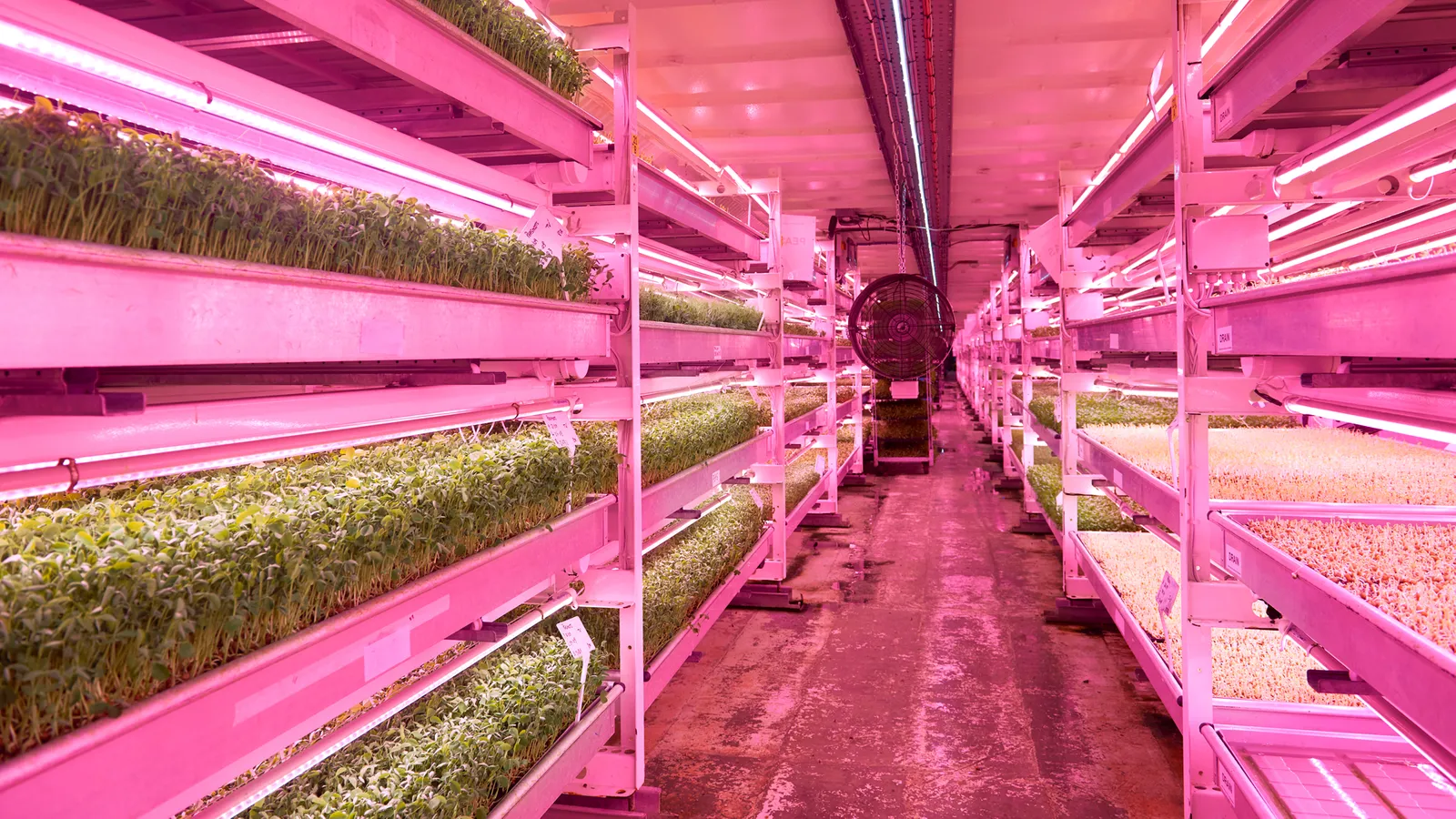The farmers boosting crops with electricity
Electrical horticulture is on the horizon, as farmers search for ways to boost productivity without harming the environment. Could we all be enjoying electrified vegetables soon?

The translucent orange cubes jiggle temptingly under the grow lights, looking for all the world like exotic confectionery, somewhere between gummy bears and Turkish delight. If it weren't for the vibrant green leaves poking out of the little air tunnels that perforate them, I might be tempted to pop one in my mouth when Maddalena Salvalaio isn't looking. She seems to read my mind. "We often have to remind visitors not to eat them," she says.
The cubes are made of hydrogel, a material with a network structure that holds liquid. It's more typically found in medical devices and nappies. But here, in the Plant Morphogenesis Laboratory at Imperial College London, Salvalaio – a research technician – and Giovanni Sena – a principal investigator – are using them to change the future of vertical farming. The secret sauce in this bold new approach is the electrodes that flank either side of each cube.
Salvalaio and Sena's experiment is one of a growing global constellation of projects that aim to boost agriculture using a variety of electrical interventions. The last decade or two have seen a proliferation of ways to electrically stimulate seeds, crops and fields: increasing yield under the influence of an electric field; shocking seeds to hasten germination; even zapping the water they are doused with. In the US, the National Science Foundation (NSF) has given millions of dollars to research the agricultural uses of cold plasma – essentially controlled lightning delivered at room temperature.
In China, the government is backing agricultural projects that use giant rigs to draw electricity into the soil to boost crop yields. In Canada, a commercial grower has been experimenting with cold plasma to fertilise its lettuces. Now startups are entering the scene, like Vivent, a Swiss company whose "EEG" can eavesdrop on plants' inner electrical lives and is being aggressively courted by the ag industry. Even the organic gardening influencer community is sniffing around the trend.
The proliferation of new projects would look very familiar to the practitioners of a strange 19th Century obsession: electroculture, in which electricity was liberally applied to plants to make them produce better flowers, leaves and fruit, or even rid them of pests – with decidedly mixed results. (Read more from BBC Future about the eccentric pioneers of vegetable electricity.)
The new crop of researchers shuns the word "electroculture", favouring terms like "smart farming" or "fourth agricultural revolution". But the underlying mechanism remains the same, and advocates are united in the conviction that, after centuries in the desert, electricity for plants is finally ready to bear fruit. The hope is that these futuristic systems can be enlisted to combat the global food crisis – reducing the environmental consequences of mass scale agriculture.
Modern agriculture presents many environmental challenges. Based on an estimate from 2005, globally, its various constituents may contribute to between 10-12% of greenhouse gas emissions each year. Production of the synthetic fertiliser created by the energy-guzzling Haber-Bosch process, which revolutionised farming in the early 20th Century, now accounts for hundreds of millions of tonnes of carbon dioxide (CO2) per year. Soil erosion from unregulated land use adds even more.
But the plant ecologist Nina Buchmann – who directs the World Food System Center at ETH Zurich, Switzerland – has little patience for critics. "Sometimes I'm tempted to ask them: Did you eat something today?" she told attendees at an agronomy awards ceremony organised by the investment company Vontobel. Agricultural companies are asked to thread a difficult needle: feed a fast-growing population but without polluting pesticides or fertiliser run-off, while lowering energy costs, using less land, and constantly increasing crop yields in an increasingly unpredictable, warming world.
Many researchers at the vanguard of the new wave of electrical agriculture think it can play a role in improving each of those aspects of food production.
Electrifying yield
To increase yield, some of the scientists are returning to inventions inspired by the "electro-vegetometer", invented by a French physicist in the 1780s – a kind of lightning rod that delivered atmospheric electricity to crops, often with less-than-desirable consequences. A more advanced version can be found in Beijing, where researchers have set up a rig that resembles the original device to infuse their plants with electricity. Unlike their predecessors, they reported excellent results, notably on green beans in 2022.
In the US, a number of institutions are trying to resurrect a different approach: artificial lightning. Lightning had long been understood to invigorate plants and even mushrooms. When the old electroculturists first tried to harness lightning's benefits centuries ago, however, dubious anecdotal results were all the approach had to recommend it. The artificial version was as likely to smite the plant as to enliven it.
But in the 20th Century, it became possible to deliver lightning more precisely. In nature, lightning generates plasma – superheated matter, usually several million degrees, that has formed into a kind of ionised gas. Cutting-edge tools from the microchip age have made it possible to wield the stuff at room temperature. Known as cold plasma, this approach to agriculture is "an extremely active area right now," says Jose Lopez, a professor at Seton Hall University who recently completed his term as director of the plasma physics programme at the US National Science Foundation. He and Alexander Volkov, a biochemist at Oakwood University in Alabama, are among those who have embraced the growing agricultural trend of zapping young seeds with cold plasma in many forms.
In his experiments, Volkov saw increases in harvest of 20-75%, depending on the plant. Treating seeds in plasma for less than a minute led to a 40% increase in potato harvests. "One cabbage farm let us experiment, to get statistics," says Volkov. "We increased cabbage production by 75%. It also tasted better." The flavour, he said, was sweeter.
Volkov was not alone. A smattering of seed-zapping studies have reported a range of benefits, from helping plants grow faster and bigger to resisting pests.
"The plasma acts by waking up the seed, to the best of our knowledge," explains Lopez. When seeds are first germinating, that's when the new plant is most vulnerable to a wide range of environmental stressors. As a consequence, the seed refuses to open until it’s happy with its environment. Hurrying along this process has been standard practice in agriculture for a long time, though it has more typically been accomplished through chemical means like acids. Plasma seems to do the same thing, but much more effectively. "It perforates the seed wall, and when you plant that seed, it is better able to take up water and soil," says Lopez. "After you treat them for just a few seconds, that plant grows faster than untreated seeds."
Plasma even appears to invigorate already-grown plants, says Lopez, whose own group at NSF used a precision tool called a plasma pencil to spot-treat sweet basil plants. The plasma stimulated more robust and healthy growth, bestowing a 20% increase in not just the height but the overall mass of the plant.
"The results are remarkable," says Lopez – though there is the small matter of how we’re still not entirely sure how any of this works, especially when it comes to electricity’s interaction with whole plants. Volkov is on the hunt for molecular mechanisms responsible for the seed boosts. The NSF, in 2017, awarded a multi-university group, which included Volkov, a $20m (£15.7m) grant to work it out. In 2022, it added another $20m.
Creeping doubts
This uncertainty goes some way to explaining why electricity in agriculture still has its share of doubters. Sceptics object that, 200 years after the first Victorians zapped their perennials to unscientific success, it is still poorly understood how exactly electricity interacts with plant biology. This same back-and-forth has emerged every time electroculture has come back into vogue since the 1700s, driving it back into useless obscurity.
"We have known for decades and decades that electric fields enhance plant growth," says Sena. The problem is that this data has never been fully reproduced; experiments were done under varying conditions. And after 200 years of being told "we zapped things and they grew more", Sena says, people can be forgiven for a bit of impatience. "Of course they grew more! But do you understand why?" he says.
But to turn this intervention into a technologically sound method, it helps to understand the fundamental science.
Unpicking the molecular mechanism of a plant’s response to an electrical field is the crux of the work Sena’s group undertakes at Imperial. Among others, they have begun to zero in on an underappreciated aspect of this response: the plant's own internally generated electrical signals. Plants send myriad of these at every growth stage and in every part of their anatomy. In a recent review, Eleonora Moratto, a doctoral student in Sena's lab, itemised the wide variety of them. Seedlings show a spike in electrical current before the emergence of roots. Grown plants send electrical signals both in response to predation and to identify themselves to friends. The distinctive shape of a flowers' electric field may identify it to favoured pollinators, but as Moratto also found, the bioelectrical characteristics of its roots also might make them tempting targets for harmful microbes.
Tools capable of listening to and deciphering this cacophony of signals have proliferated. Even so, in a 2021 review of the state-of-the-art in bioelectronic implantable devices for plants, Eleni Stavrinidou and her co-authors at Linköping University, Sweden pointed out that these remain underutilised, even though they would be extremely helpful at monitoring and modulating crop biology. This year the World Economic Forum named plant wearables a top 10 technologies of 2023 for their potential to improve agriculture. This is precisely what some commercial growers and startups are trying to use them for.
Wearables for plants
Few places take crops more seriously than The Netherlands. Their greenhouses can look more like microchip fabrication plants than garden centres. That's certainly true of Tomatoworld, an 8,000 sq m (86,000sq ft) , high-tech research greenhouse facility in Honselersdijk, Holland, where the gardeners wear lab coats. "If you could see how we produce tomatoes now…." says Ab van Marrjewik, who has made his living as a tomato grower for 47 years. That can be a hard task at scale: tomatoes require particular temperatures, and to grow to their full potential they need to avoid stresses.
Tomatoworld is trialling a cutting-edge technology, a kind of "EEG" for tomatoes. The technology, called PhytlSigns – made by Vivent, a plant technology business based in Switzerland – uses the plant equivalent of an implanted brain electrode to listen to the signals in the stem. Together with deep learning algorithms trained on the plant electrical signalling literature, this system forms the basis of a kind of plant-to-English translator. The point of this is to give greenhouse operators access to the plant’s own early warning systems that indicate thirst or pest infection – before they are bad enough to require major disruptive intervention. Tomatoworld placed the first of its experimental sensors in 2021, and the following year it says it began to see results.
The PhytlSigns interface, which looks a bit like a heart monitor, codes a plant's squiggly electrical activity into three easily understood bands: green means the tomato plant is having a normal day – experiencing agreeable temperatures, absorbing enough water, and taking in normal amounts of CO2. Yellow indicates some kind of stress. If you see orange, everyone has to stop what they’re doing and figure out what went wrong.
This Rosetta stone, van Marrewijk hopes, will help growers like him to understand how his baby plum tomatoes feel about the technological interventions that are set to populate the agricultural future.
For van Marrewijk at least, the tomato EEG seems to be working. One Saturday morning at 5:30am, the temperature in the greenhouse dipped to 12C (56F), from the prescribed constant of 15-16C (59-43F). A later review of the PhytlSigns readouts showed the as the greenhouse temperature dropped below the plants' comfort zone, the amplitude and frequency of their electrical signals charted a steady rise from happy green into alarmed yellow.
The early sensors were a crude way of eavesdropping on the plant signals, says Nigel Wallbridge, chief scientist at Vivent. "It's a bit like listening to a football crowd rather than an individual conversation," he says. Two years later, however, while the sensors remain at their listening posts at Tomatoworld, upgraded versions have proliferated beyond tomatoes and into the world beyond the greenhouse. "We are doing way more outdoors now," says Wallbridge. "Sugarbeet, potatoes, we are even listening to the signals in seeds." A range of new partners have snaffled PhytlSigns sensors into their own field trials in Italy, Germany, France, the UK, the Netherlands and Sweden. Agricultural giant Bayer is among them.
One of the most welcome new signals is a plant’s response to mildew, which can be devastating. "Once you can see it, your crop is already gone," says Wallbridge. After an airborne spore lands, it only takes a few days to progress to an incurable disease, at which point you have to raze the whole crop. "You can only prevent it, never cure". Preventive measures include spraying every week with a toxic chemical, whether there is evidence of infestation or not. Being able to tap into the plant’s own defence signals instead of relying on visible evidence is a game changer, Wallbridge says. "That opens the way for treatments that don’t involve constant pre-emptive spraying".
Vivent also shares its data with universities, which yields even more insight. When Kavya Sai and her colleagues at the National Institute of Technology Jalandhar, in Punjab drilled down into the signals obtained by PhytlSigns, they were able to detect and classify specific nutrient deficiencies with high accuracy. "Plants leave testimonies of their underlying physical state in their electrophysiological data," the authors wrote, revealing information as specific as iron and manganese deficiencies.
Wallbridge thinks this is why wearable technology for plants will play such a crucial role in the coming electrical revolution in agriculture. “We have drones, satellites, and soil sensors, but none of those gives you access to the plant’s internal state,” he says. Eavesdropping on these is powerful because it makes it possible to use less of everything. Targeting specific nutrient deficiencies lets you use less fertiliser, which will mean fewer nitrates leaching into the groundwater. "You can start using the right amounts if you know exactly what the plants actually need and when they need it," he says, be that water, pest control, food – even land.
The sky is the limit
Unlike other needs, however, you can’t just make more land. For a long time, the best answer to this problem has been the promise of vertical farming, which would allow crops to grow on any surface.
There's just one problem, says Sena. What we call vertical farming is a bit of a misnomer. We are not growing plants vertically; we are vertically stacking narrow boxes of horizontal growth on top of each other.
That's because roots don’t do vertical. Roots obey the law of gravity. They seek water and they seek "down". This is why, incidentally, it is very difficult to grow plants with many roots in space. Without gravity, roots wander all over the place, making it logistically difficult to feed them adequately.
What if vertical farming literally did what it says on the tin? What if it was possible to grow crops and trees whose roots extended lengthwise instead of down?
Roots grow down because the living organism senses the pull of the gravitational field and the presence of water and coordinates its tissue to follow. However, that's not all roots can sense. They can also sense electric fields. What's more, that sense may be able to override the others. Scientists have understood for the past 100 years that under an electric field, anything will crawl toward the cathode end. This phenomenon, increasingly well understood in medicine for wound healing, has now become a hot topic in plant research as well: an electric field has veto power over roots' response to the gravitational field.
Last year Salvalaio and Sena showed for the first time in precise molecular detail how to use specific doses of electricity to make the Arabidopsis plant re-orient the direction of its root growth. In other words, they made it grow how they wanted it to grow.
Hence those tasty-looking cubes. Salvalaio and Sena partnered with the Dyson School of Design Engineering in London to develop the special 3D-printed patterned hydrogel cubes, capable of housing the growing Arabidopsis plants – and the electrodes that will guide their roots' growth into the sideways position. The bright green leaves make it clear that the aerating tunnels have proven a nurturing environment. Their roots snake thickly throughout.
Salvalaio aims to start zapping later this summer. If things go well, saying "the sky is the limit" would be an understatement. "Being able to control the direction of root growth would mean we could grow trees from the ceiling as well as a wall," says Sena. With this new electrical breakthrough, it would even be possible to grow trees in zero-gravity environments. Perhaps soon there will be trees on the International Space Station (ISS), or forests on the moon.
-bbc







